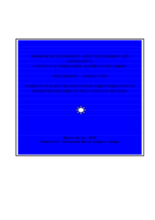Long-term separation between child and family due to armed conflict creates a number of challenges for family reunification programs. Whereas emergency programs appropriately work towards managing effective “lost and found” type of operations, after long separation, the physical act of reunifying is often not sufficient. This is particularly true for children who are placed in residential centers as an interim solution and for children returning to extended family members. Experience shows that after years in care, children have become institutionalized and are commonly ill prepared for community life. Families also change, both as a result of post-conflict circumstances and family reconstitution. If tracing agencies do not develop specific strategies to prepare the children and families, abrupt reunifications can result in additional family breakdowns and runaway children. At some point, an equal emphasis on reintegration, not just reunification, becomes crucial.
Eight years after the genocide, the International Rescue Committee (IRC)-Rwanda has learned much about how to adapt its unaccompanied children’s (UAC) work within an evolving post-conflict era. In 1999, IRC’s classic reunification program for children in centers introduced new ways to document and trace “untraceable children”, and in 2000, it designed an innovative community-based reintegration strategy for difficult-to-place children. As a result, 1192 formerly institutionalized children are either already, or about to begin, living with families. Although smaller than the impressive reunification number in the early years, these numbers are significant because they represent the most difficult cases, effectively considered closed after failed attempts to trace or reunify by previous agencies.
This paper hopes to contribute to a sorely under-documented field of how to reintegrate institutionalized children back into the community in a post-conflict environment. It provides a brief description of IRC Rwanda’s Reunification and Reintegration Program for Unaccompanied Children, emphasizing its innovative nature and promising field methodologies. It includes a review of core principles and a programmatic overview of center and community-based work, outlining key steps in the process. It will also provide a brief review of good practices and offer some points of reflection for future work with children in post-conflict situations.
©International Rescue Committee, Rwanda

